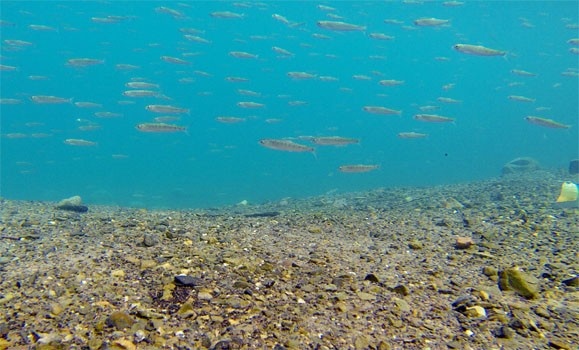Media Releases
» Go to news mainBig things come in small packages: the ocean's internet fits on a transmitter smaller than a usb

(HALIFAX, CANADA) – June 11, 2015 – A new paper, published in Science, details the explosion in aquatic animal tracking research over the past 30 years and its impact on discoveries about the movements, migrations, interactions and survival of both common and elusive aquatic species.
The review describes a profound revolution, including over 20 examples of scientific breakthroughs, in global ocean observation science achieved through advancements in acoustic and satellite telemetry—tracking via electronic tags placed on organisms ranging from tiny neonate fish to large whales, which transmit data to fixed or mobile receiver stations or orbiting satellites.
Electronic tags can now weigh less than a penny, can transmit for more than 10 years, and can be attached to almost any species, at any life stage, to collect high-resolution data in four dimensions (2D-horizontal, depth and time).
“The vastness and impenetrability of the ocean has historically limited our ability to acquire and process information on animal movements. Telemetry has significantly enhanced our capacity to predict and plan in the face of climate change and human influence,” said Sara Iverson, scientific director of the Ocean Tracking Network and corresponding author on the paper. Iverson is a marine biology researcher at Dalhousie University, which is also home to the headquaters of the Ocean Tracking Network.
Telemetry data have revealed the often-mysterious migrations of endangered marine animals like leatherback turtles, basking sharks, European eels and Pacific bluefin tuna. These discoveries, and the increasingly sophisticated technology behind them, generate critical knowledge towards conservation recommendations. Tracking studies also pinpoint successes and limitations of current management plans. For example, acoustically tagged reef fish were shown to regularly move outside their Marine Protected Area, putting them at risk.
“In the future, we could be looking at spatially dynamic MPAs, which move annually with predictions of animals’ response to their environments,” said Nigel Hussey, lead author and researcher at the University of Windsor with the Ocean Tracking Network.
Acoustic and satellite telemetry studies are being combined with other biological measurements like genetic analysis or physiological status. These data help determine drivers behind animal behaviour to forecast how anthropogenic and climate changes will affect species and populations.
Aquatic animal movements and migrations transcend geopolitical, economic, and management boundaries. Telemetry studies in the last decade have documented movement over transoceanic scales, to regions unreachable by humans, and into some of the harshest parts of the ocean, providing the groundwork for “next-generation aquatic governance frameworks.”
“The ocean will continue to change,” said Hussey. “Global collaboration—among industry and science sectors, and researchers themselves—is imperative to get ahead of these changes before they catch up to us.”
About Ocean Tracking Network
The Ocean Tracking Network (OTN) is a $168-million research and technology development platform headquartered at Dalhousie University, in Halifax, Nova Scotia. Starting in 2008, OTN began deploying Canadian state of the art acoustic receivers and oceanographic monitoring equipment in key ocean locations and establishing partnerships with a global community of telemetry users. OTN is documenting the movements and survival of aquatic animals carrying electronic tags and how both are influenced by oceanographic conditions.
OTN is funded by the Canada Foundation for Innovation and the Natural Sciences and Engineering Research Council of Canada, with additional support from the Social Sciences and Humanities Research Council of Canada and the Nova Scotia Research and Innovation Trust, as well as international partner contributions. oceantrackingnetwork.org
Media Contact
Nikki Beauchamp
n.beauchamp@dal.ca
(902) 494-4405
Recent News
- Media opportunity: Dalhousie University researchers discover seasonal shifts in vitamin abundance in the ocean and hints that climate change could reduce the nutrition levels of the seafood we eat
- Media release: Canadian researchers capture rare video of killer whales and dolphins working together to forage salmon, suggesting the two species have forged a co‑operative relationship
- Global Aid Cuts Put Millions at Risk: Dr. Robert Huish Available for Expert Commentary
- Media opportunity: Dalhousie University research tracks drop in fatal opioid overdoses in Nova Scotia early in pandemic, followed by steady increase in deaths linked to illicit drugs
- Media release: Dalhousie University launches new institute to drive digital agriculture in Atlantic Canada
- Media Release: Faculty of Science student Isaac Bahler named Dalhousie University’s 95th Rhodes Scholar
- Media opportunity: Unique national study to examine social, biological factors of people with multiple sclerosis in Canada
- Media opportunity: Sleepless in Atlantic Canada: Dalhousie University research uncovers the high rate of sedative use in the region, shares ways to reduce reliance on sleeping pills
